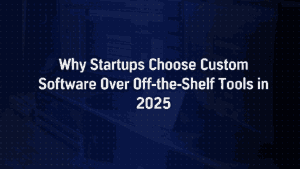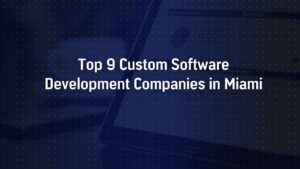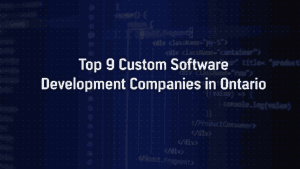Budgeting for Custom Software Projects: A Complete Cost Breakdown
Budgeting is critical for any custom software project. Poor planning is a top reason projects exceed deadlines and budgets. Experts emphasize that upfront scoping (requirements, market research, and design) is an “investment, not a cost.” For example, Empyreal Infotech’s discovery phase “collects all the details” so the team ends up with “a clear roadmap: user personas, prioritized feature lists, and high-level architecture ideas.” This kind of front-loaded planning reduces surprises later.
Discovery and Planning: Laying the Groundwork
Good budgeting starts with detailed planning. Break the project into phases and estimate each one. Typical pre-development stages include:
-
- Discovery/Research: Identify goals, users, and requirements (usually 1-2 weeks, roughly $2k-$8k).
-
- Prototyping: Build wireframes or mockups to validate design (1-3 weeks, up to $5k).
-
- UI/UX Design: Create the app’s look and feel (2-4 weeks, roughly $1k-$10k).
Empyreal integrates user feedback early: sprint planning and design sessions turn high-level goals into concrete user stories. By defining scope in advance and involving stakeholders (through demos and reviews), the team avoids rework and cost overruns later. In short, build your budget around a clear scope and dedicated discovery. As Pixxel Solutions notes, every project stage (requirements, design, development, testing, deployment, maintenance) should be plotted on the timeline.
MVP vs. Full Build: Cost and Timeline
One powerful budgeting strategy is to start with a Minimum Viable Product (MVP) rather than building the entire product at once. An MVP has just the core features needed to validate your idea. This approach is faster and cheaper: “Building an MVP is not only faster than a full-fledged product but also more cost-effective.” SoftTeco reports that in 2025, an MVP can range from $15k-$150k on average, depending on complexity. For example, a simple MVP might run $5k-$15k and take approximately 2-4 months, while a complex MVP (with AI, custom integrations, etc.) might cost $45k-$150k+ and take 6-12 months.
Starting with an MVP forces you to prioritize. This lean focus “ensures you don’t burn through funds before validating your core idea.” By stripping out nice-to-have features, an MVP lets you test the market cheaply and gather user feedback early. Empyreal’s agile process builds iteratively, with client demos each sprint, so the scope can be adjusted on the fly. In practice, this means you fund the most important features first and delay extras. Later, when additional features are needed, you add them in controlled increments, rather than paying upfront for unproven functionality.
Cost Breakdown: Key Components of Your Budget
A realistic budget is broken down by category. Here are the major cost components in a typical custom software project:
-
- Frontend Development: Building the user interface (approximately $5k-$30k for a simple-to-moderate app).
-
- Backend Development: Server-side logic, APIs, and database work (approximately $5k-$40k depending on features and scale).
-
- Database Setup: Designing and configuring the database (approximately $1k-$10k).
-
- Third-Party Integrations: Connecting services like payment gateways, maps, analytics, etc. (approximately $1k-$20k depending on number and complexity).
-
- Quality Assurance & Testing: Manual and automated tests to ensure reliability (approximately $2k-$15k).
-
- Project Management: Scrum masters or PM time (often estimated at approximately 10% of the total budget).
Beyond core development, account for post-launch costs. Pixxel Solutions recommends setting aside 15-20% of the original development cost each year for maintenance, server fees, updates, and bug fixes. This covers things like security patches, performance tuning, and small enhancements.
Ongoing Maintenance
Software is never truly “done.” Discipline Infotech notes that after launch, you should budget approximately 15-20% of the initial build cost per year for hosting, updates, and support. This includes cloud/server fees, content updates, and minor improvements.
Miscellaneous and Contingency
Always include a buffer (typically 10-20% of the budget) for unexpected expenses. Plan for things like potential delays, feature changes, or technical hurdles. A well-structured budget template can help track all this. For example, templates typically have separate lines for Personnel, Tools/Software, Infrastructure (hosting, licenses), Testing/QA, Management, and a Miscellaneous category. Using such a template (Excel, Google Sheets, or a project tool) brings transparency and helps avoid missing items.
Timeline and Agile Process
A detailed timeline is as important as the budget itself. Pixxel Solutions emphasizes that a solid schedule (covering requirements, design, development, testing, deployment, and maintenance) acts like a project roadmap. Breaking the work into sprints or phases ensures teams know what to do when. This discipline “keeps everything organized and predictable” and ultimately “prevents you from overspending” on a drawn-out project.
In practice, this means scheduling regular milestones (e.g., bi-weekly sprints) and review points. At each sprint review, Empyreal, for instance, delivers working features for client feedback. These demos help catch problems early, so you can re-prioritize without large rework later. A good timeline also aligns with Agile practices: daily standups, sprint planning, and retrospectives keep the team on track and the client in the loop. In short, map out your project phases clearly to manage costs and scope tightly.
Empyreal Infotech’s Agile and Transparent Pricing
As an example, Empyreal Infotech combines an agile workflow with clear pricing. They advertise fixed “flat rates” for their development teams, so clients pay a predictable hourly rate rather than confusing markups. Empyreal also promises no surprise surcharges. For instance, they won’t tack on hidden “expedited service” fees if you need work in a rush. Their model even includes bulk-hour discounts for larger projects.
On the process side, Empyreal follows Scrum: once features are defined, the team estimates tasks in sprint planning, then commits to two-week development cycles. Clients see progress in each sprint review. Empyreal notes that this constant feedback loop keeps the scope aligned with the budget, since changes are discussed regularly rather than piling up unnoticed. In other words, the agile approach itself becomes part of the budgeting strategy: incremental development under transparent rates means you always know how much work remains and can adjust scope before costs blow up.
Hidden Costs to Watch
Be aware of often-overlooked expenses beyond core development. These include:
-
- Hosting & Infrastructure: Cloud or server costs vary with usage. A traffic spike may force you to upgrade hosting tiers, raising your bill. Budget for scalable cloud plans (AWS, GCP, Azure) and include fees for databases, CDNs, etc.
-
- Domain and Security: Domain registration (approximately $10-$50/year for a typical name, more for premium domains) and SSL certificates (approximately $10-$500/year) are essential but small line items. Also include any fees for backup or monitoring tools.
-
- Third-Party Services: Many apps use paid APIs or software (payment processors, SMS gateways, analytics services, CRM systems). These integration fees can add up. For example, some API plans have monthly charges. Factor in any license or subscription costs.
-
- Launch and Marketing: Don’t forget deployment costs (CI/CD tools, app store fees) and initial marketing. For an MVP, SoftTeco suggests budgeting for launch-related tasks (some projects spend up to $50k on promotion).
-
- Contingency: Finally, allocate a buffer (e.g., 10-20%) for scope changes, delays, or “surprise” fixes. Experience shows that unfinished requirements or last-minute tweaks are almost inevitable; leaving room in the budget can prevent a crisis.
Budgeting Tips and Tools
-
- Start Lean – Prioritize Features: Always aim for a prioritized MVP first. Listing must-have versus nice-to-have features helps keep the initial budget focused. As one source warns, overspending on unnecessary features (or ignoring feedback) is a common startup mistake. Begin with the essentials; you can always add secondary features once the core app proves its value.
-
- Use Reusable Components: Leverage existing libraries, frameworks, or cross-platform tools (like React Native, Flutter, .NET MAUI, etc.) where appropriate. Discipline Infotech suggests using reusable components and cross-platform frameworks to cut down development time. This can significantly reduce coding effort compared to building everything from scratch.
-
- Choose the Right Engagement Model: If your scope is well-defined, a fixed-price contract can lock costs upfront. If it’s likely to evolve, an hourly/time-and-materials model offers flexibility. Fixed bids work best for small, clear projects, while larger or research-heavy projects often suit Agile hourly billing.
-
- Include Contingency: Allocate roughly 10-20% of the estimated budget as a contingency fund. This guards against inevitable scope creep or delays. Think of it like insurance: if you don’t use it, great; if issues arise, you won’t have to re-budget midstream.
-
- Track Actuals with Templates: Use a structured budget template to monitor spending versus the plan. ALMBoK’s software development budget template breaks costs into sections like Personnel, Tools, Infrastructure, Testing, Management, and Miscellaneous. Regularly updating actual costs against estimates can flag overruns early.
-
- Communicate Constantly: Transparent communication is as crucial as transparent pricing. Schedule regular check-ins (demos, status meetings) so any change in requirements is caught early. When clients and developers stay aligned, the likelihood of costly missteps drops.
-
- Avoid Common Pitfalls: Budget overruns often stem from unclear scope or skipped QA. Always define features clearly before committing, and do not skimp on testing. Bugs found late can be far costlier to fix. Allocate enough time and money for thorough QA, as Discipline Infotech cautions that skipping tests can send costs “off the rails.”
Conclusion
A successful custom software project begins with clear budgeting and scope. Break the project into phases (discovery, design, development, etc.), estimate each piece, and include all hidden items (hosting, maintenance, licenses). Use agile planning to regularly re-evaluate costs, and demand transparency from your vendor (Empyreal’s “flat rate, no-surprise” approach is one model to emulate). As Discipline Infotech summarizes, a well-defined budget and scope will help you “avoid surprises” and build your application efficiently. With detailed costing, regular reviews, and a contingency buffer, you can navigate uncertainties and keep your custom software project on track and on budget.




